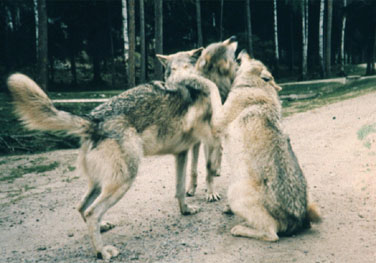
Natural behaviour |
||
|
Dogs thrive in small social groups called packs. Dog packs are hierarchical and have strong group identity: each individual has a rank, and there is intense loyalty within the group. A dog is always aware of its rank relative to other individuals in the group. Dogs establish the hierarchy through aggressive play involving dominance and submission. Ideally, the dominant/submissive social structure of dogs avoids conflict and enforces social stability (see Canine social systems). When they are kept as pets, dogs include humans in their hierarchy. An assertive dog may consider itself the alpha animal (dominant) and regard its human master to be subordinate. This can lead to loss of human control over the animal (see Dominance aggression). |
||
 |
||
| The wolf to the left is dominant (signalled by upright tail) and the wolf to the right is submissive (signalled by hidden tail and licking of the corner of the mouth of the dominant wolf). Photo: Lena Lidfors | ||
 |
||
| One wolf is by putting the leg on the back of the dominant wolf resulting in a fight between the wolves. Photo: Lena Lidfors | ||
 |
||
| The dominant wolf wins and the submissive one shows submissive behaviour manifesting the original hierarchy. Photo: Lena Lidfors | ||